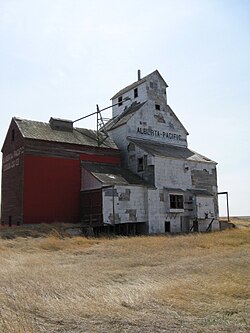Cardston County | |
|---|---|
 Oldest grain elevator in Alberta, located in Raley | |
 Location within Alberta | |
| Country | Canada |
| Province | Alberta |
| Region | Southern Alberta |
| Census division | 3 |
| Established | 1954 |
| Incorporated | 1999 (County) |
| Government | |
| • Reeve | Randy Bullock |
| • Governing body | Cardston County Council |
| • Administrative office | Cardston |
| Area (2021)[2] | |
| • Land | 3,358.39 km2 (1,296.68 sq mi) |
| Population (2021)[2] | |
| • Total | 4,856 |
| • Density | 1.4/km2 (4/sq mi) |
| Time zone | UTC−7 (MST) |
| • Summer (DST) | UTC−6 (MDT) |
| Website | cardstoncounty.com |
Cardston County is a municipal district in southern Alberta, Canada. It is located in Census Division 3 around the Town of Cardston.
The municipal district was established on January 1, 1954, through the amalgamation of the Municipal District of Sugar City No. 5 and part of the Municipal District of Cochrane No. 6. On January 1, 2000, the name was changed from Municipal District of Cardston No. 6 to Cardston County[3]
Geography[edit]
Cardston County, located in southern Alberta, Canada, boasts a diverse landscape ranging from rolling plains to stunning mountain vistas. Its terrain is influenced by the Waterton River, providing fertile farmland and scenic beauty."
Lakes[edit]
Communities and localities[edit]
|
The following urban municipalities are surrounded by Cardston County.[4]
|
The following hamlets are located within Cardston County.[4]
|
The following localities are located within Cardston County.[5]
- Localities
|
|
- Other places
Demographics[edit]
In the 2021 Census of Population conducted by Statistics Canada, Cardston County had a population of 4,856 living in 1,143 of its 1,387 total private dwellings, a change of 8.4% from its 2016 population of 4,481. With a land area of 3,358.39 km2 (1,296.68 sq mi), it had a population density of 1.4/km2 (3.7/sq mi) in 2021.[2]
In the 2016 Census of Population conducted by Statistics Canada, Cardston County had a population of 4,481 living in 1,043 of its 1,260 total private dwellings, a 7.5% change from its 2011 population of 4,167. With a land area of 3,429.82 km2 (1,324.26 sq mi), it had a population density of 1.3/km2 (3.4/sq mi) in 2016.[8]
See also[edit]
References[edit]
- ^ "Municipal Officials Search". Alberta Municipal Affairs. May 9, 2019. Retrieved October 1, 2021.
- ^ a b c "Population and dwelling counts: Canada, provinces and territories, and census subdivisions (municipalities)". Statistics Canada. February 9, 2022. Retrieved February 9, 2022.
- ^ Municipal Profile Archived 2006-10-05 at the Wayback Machine - Alberta Municipal Affairs
- ^ a b "Specialized and Rural Municipalities and Their Communities" (PDF). Alberta Municipal Affairs. January 12, 2022. Retrieved January 21, 2022.
- ^ "Standard Geographical Classification (SGC) 2006, Economic Regions: 4803001 - Cardston County, geographical codes and localities, 2006". Statistics Canada. March 5, 2010. Archived from the original on May 25, 2013. Retrieved August 11, 2012.
- ^ Geo-Administrative Areas (Hamlet, Locality and Townsite Culture Points) (Geodatabase layer) (Map). AltaLIS. October 26, 2020. Retrieved October 2, 2021.
- ^ Woolford Flat
- ^ "Population and dwelling counts, for Canada, provinces and territories, and census subdivisions (municipalities), 2016 and 2011 censuses – 100% data (Alberta)". Statistics Canada. February 8, 2017. Retrieved February 8, 2017.

